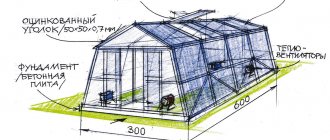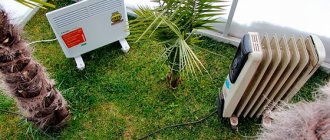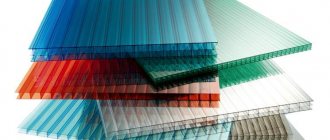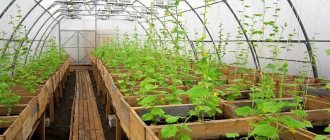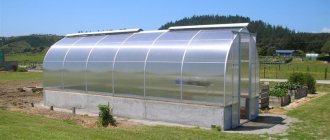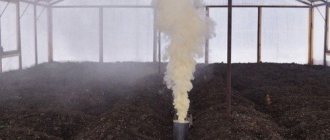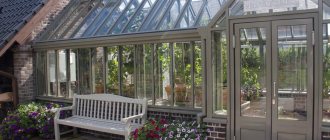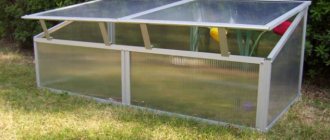Nuances of selecting the necessary materials
Before you start assembling a polycarbonate greenhouse with your own hands, you need to get acquainted with some design features and rules for choosing the necessary components.
First of all, you need to carefully choose the material for the frame. It should be borne in mind that it is possible to use wooden blocks or plastic pipes, but with a metal profile the structure will be much stronger and more durable.
The second step is to decide on the covering material. Polycarbonate performs well in this capacity. In addition to other properties, it is quite easy to work with.
The thickness of the material should directly depend on the size of the structure, because the thicker the polycarbonate, the stronger it is. Accordingly, structures of impressive size will require an increase in the thickness of the sheets.
Lastly, you can consider color options for polycarbonate. In most cases, white or transparent material is used, but to make the greenhouse decorative, it is possible to use various colors. In the photo of the greenhouse assembly you can see color options for polycarbonate.
Some recommendations
Tips and tricks
It does not need to be collected for the winter; its service life is much longer than that of others and lasts longer. This design is very high quality and reliable, and the special materials will not let you down and will last for decades.
| Greenhouse classes | Dimensions |
| Premium | 4x2, 6x2, 8x2,10x2, 12x2 |
| Optimum | 4x2, 6x2, 8x2,10x2, 12x2 |
| Economy | 4x2, 6x2, 8x2,10x2, 12x2 |
So:
- Each of the greenhouses has doors on both sides, which makes them very convenient. There are also opening windows with special stainless steel fasteners.
- Before installation, it is necessary to pour the foundation (see Foundation for a polycarbonate greenhouse - do-it-yourself installation), and the assembly work will last throughout the day.
- Also, the paint on the walls will not wash off for a long time and you will not have to paint them often. Pipes and arcs are made of the best materials, they are also made thicker, and special fasteners are used in the most extreme regions. They will ensure long-term operation of this design. As you can see, the Honeycomb greenhouses are very reliable and are made to last for many years. The plants will feel comfortable in them and it will be easy for you to care for them.
- Typically, additional equipment and automatic watering are installed in such greenhouses. This is a great idea for this particular design.
- Since you will be choosing a greenhouse for a long time, it is best to first look at the materials and characteristics of the parts. After all, everything depends on the quality of the arcs, polycarbonate and others.
Before ordering a greenhouse, make a foundation for it. This way it will last longer and will be more reliable in itself. You will need to carefully weld everything, install it correctly, and make special fasteners. It is recommended to watch a video on the selection and assembly of the structure.
Distinctive features of polycarbonate
Before you figure out how to assemble a greenhouse with your own hands, it’s worth understanding what useful distinctive features polycarbonate has. A distinctive feature of the material is its honeycomb structure, which makes the structure light, retains heat well inside the greenhouse and allows sunlight to pass through.
Polycarbonate is highly durable, but if there is a risk of heavy winter precipitation, you should choose thicker sheets. Among other things, the material is absolutely moisture resistant, not subject to corrosion and has a service life of at least twenty years. Despite all the advantages of polycarbonate, it has an affordable price.
When choosing this material, we are often talking about more massive, non-dismountable greenhouses, which may have separate heating. Polycarbonate is frost-resistant and is perfect for year-round use.
That is why it is worth using a reliable and durable metal profile frame. It is convenient that in a non-demountable greenhouse it is possible to equip an automatic watering system, which will help save energy and time.
There are a number of important features of the material that you should pay attention to when deciding on its use:
- the material, for its full and long-term use, requires a more thorough and careful approach to arranging the frame;
- it is necessary to carefully approach the process of transporting polycarbonate, since it is sold in large sheets that can receive mechanical damage;
- the material has the ability to expand or contract depending on the ambient temperature and this must be taken into account during installation.
It is impossible not to mention some of the disadvantages that accompany the use of polycarbonate as a covering material for greenhouses:
- the material requires a rather careful attitude during washing, as it is susceptible to scratches and, as a result, loss of decorativeness;
- When purchasing polycarbonate, it is really important to give preference to options with a special coating in the form of a film that protects the material from exposure to ultraviolet rays. If there is no such film, the material will begin to quickly deteriorate and will not last for several years;
- When using polycarbonate for arched greenhouses, excessive reflection of sunlight is possible, which can negatively affect the plants growing in it.
Choosing a location for a greenhouse
When choosing the location where the greenhouse will be located, it is worth considering several nuances.
- Firstly, the best place for the greenhouse will be the most lit place.
- Secondly, it is necessary to leave a sufficient amount of space on all sides of the structure for further possibility of its maintenance.
- Thirdly, you should definitely take into account the shadow cast from trees and buildings on the site.
A good solution could be to position the greenhouse in such a way that one of the walls becomes the wall of the house. This will not only increase the strength of the building, but will also make it possible to save on materials.
Assembly of the structure
The procedure for performing the work is outlined in the product instructions:
- Check that all components are present.
- Start installation from the door section. Bolt 4 horizontal profile beams to it. At the top is a place for the upper arched part.
- Assemble the gable part with the door. To do this, add vertical posts.
- Attach the middle and lower horizontal crossbars to the resulting end on the left and right.
- On one side, between the longitudinal beams, secure the side vertical arcs.
- Attach the top horizontal beam to the top of the assembled end piece. Screw the apical arched fragments to it along the entire length of the greenhouse.
- Do the same manipulations with the second side.
Attention! Do not over-tighten the bolts during initial assembly.
If the length of the greenhouse is 6 m or more, special spacers are placed inside under the arches to maintain rigidity. Assemble and bolt the opposite gable of the greenhouse. Tighten the fasteners. Install the greenhouse into the ground (using pegs) or into the foundation (using self-tapping screws).
Check the evenness of the structure. If the greenhouse has a slope, compensate for this by any means available. Finally, install the fittings. Check the functionality of the moving elements.
Cover the greenhouse with polycarbonate. Use roofing screws and thermal washers. For end segments, the material must be cut. Cover the joints with perforated tape. It will protect the casing from moisture and dirt getting inside.
Advice. If you don't understand the text instructions, watch the video.
Foundation
Before talking about the construction of the structure itself, it is necessary to pay attention to the assembly of the base, that is, the organization of the foundation.
As with other buildings, it is very important and the strength and reliability of the greenhouse will largely depend on it. It is permissible not to use a foundation if we are talking about small structures.
There are two options for organizing the foundation:
- tape - this option is more expensive and will require more time to implement. It is necessary to prepare a foundation pit and place the formwork, then fill the resulting base with sand-cement mortar. The final hardening of the foundation will occur in 25-30 days.
- pile - a faster and more economical option, the essence of which is that metal pins are driven into the places where the greenhouse is attached to the ground, and then welded to the frame of the structure.
Polycarbonate
Attaching polycarbonate to the frame will not be difficult, since the material is really convenient to work with.
The most important thing is to use special self-tapping screws or screws equipped with a sealing gasket that will not allow moisture to get inside and harm the metal frame.
Description of design
The reinforced greenhouse Summer Resident is a frame made of a welded galvanized profile with a thickness of 1.2 mm. Pipe thickness - 30x20 mm. An arched structure of increased durability and strength is assembled from arched and straight elements. Such characteristics of the greenhouse are given by the frequent arrangement of the supporting arches: every 0.65 m.
Attention! The manufacturer’s branded product line also includes models of the Standard type (pipe thickness is 20x20 mm and a 1-meter step between the arc beams) and Luxury (consists of double arcs 20x20 mm at a distance of 0.65 m from each other).
Product width - 2.98 m. Height - 2.1 m. Factory base length - 4 m. At the request of gardeners, extensions are available at intervals of 2 m - up to 6, 8, 10 m, etc. The manufacturer has included the possibility of purchasing additional sections and their addition to the operating greenhouse.
The connection of frame parts is carried out according to the pipe-to-pipe principle. Then it is sheathed with cellular polycarbonate. For a 4-meter greenhouse you need 3 sheets of standard size (2.1x6 m). The structure has a door (1 meter wide) and a window at the opposite end. Additionally, side windows and spacers for tying up planted crops are ordered. A standard greenhouse in online stores costs at least 21 thousand rubles.
Attention! The company provides a one-year warranty and promises simple exchange or return of defective products.
